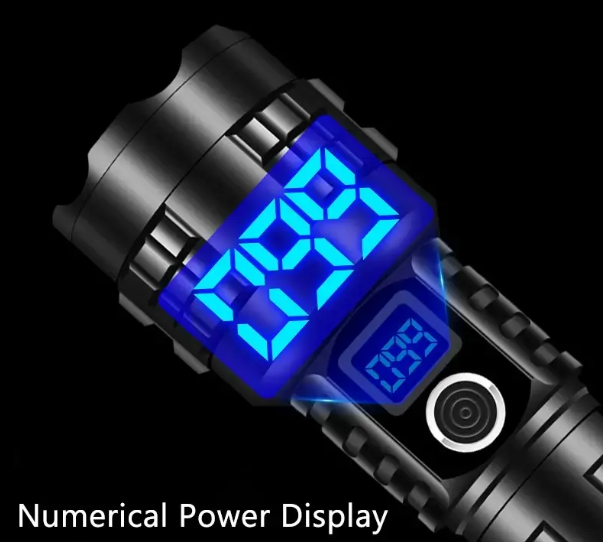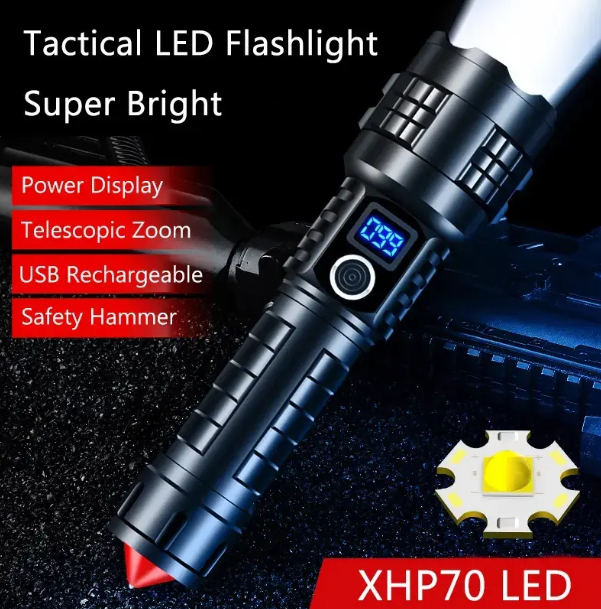Flashlight users often seek a balance between portability and robustness, making material selection crucial. Magnesium flashlights and aluminum models offer distinct advantages, particularly in weight and durability. Aluminum alloy, for example, is lightweight and resists corrosion, ensuring reliable performance in wet conditions. Its excellent heat dissipation also prevents overheating, extending the flashlight’s lifespan. Understanding these trade-offs helps users choose a flashlight that aligns with their specific needs, whether for outdoor adventures or tactical applications.
Key Takeaways
- Magnesium flashlights are light, great for hiking and camping trips.
- Aluminum flashlights are tougher and handle impacts well, perfect for tough jobs.
- Think about your needs: pick magnesium for easy carrying or aluminum for lasting strength.
- Taking care of both types helps them work well for a long time.
- Think about the weather: aluminum works in harsh conditions, while magnesium is better for mild ones.
Properties of Magnesium Alloy and Aluminum

Weight and Strength Comparison
Magnesium alloy and aluminum differ significantly in weight and strength. Magnesium alloy is one of the lightest structural metals available, making it an excellent choice for portable tools like flashlights. Aluminum, while slightly heavier, offers superior tensile strength, which enhances its ability to withstand mechanical stress. Users often prefer magnesium flashlights for their lightweight design, especially during extended outdoor activities. However, aluminum flashlights provide a sturdier build, making them ideal for situations requiring higher impact resistance.
Corrosion Resistance and Maintenance
Both magnesium alloy and aluminum exhibit varying levels of corrosion resistance. Aluminum naturally forms a protective oxide layer, which shields it from rust and degradation. This property makes aluminum flashlights highly durable in wet or humid environments. Magnesium alloy, on the other hand, is more prone to corrosion without proper surface treatments. Manufacturers often apply protective coatings to magnesium flashlights to enhance their longevity. Regular maintenance, such as cleaning and drying, ensures both materials perform optimally over time.
Durability Under Stress and Impact
Aluminum flashlights excel in durability under stress and impact. Their robust structure resists dents and deformation, even in demanding conditions. Magnesium flashlights, while lighter, may not offer the same level of impact resistance. However, they still perform well under moderate stress due to the inherent strength of magnesium alloy. For users prioritizing durability in rugged environments, aluminum remains the preferred choice. Magnesium flashlights, however, cater to those seeking a balance between strength and portability.
Magnesium Flashlights vs Aluminum Flashlights: Trade-offs

Portability and Usability
Portability plays a crucial role for flashlight users, especially those engaged in outdoor activities. Magnesium flashlights excel in this area due to their lightweight construction. Their reduced weight minimizes fatigue during extended use, making them a preferred choice for hikers and campers. Aluminum flashlights, while slightly heavier, offer ergonomic designs that enhance usability. Features like textured grips and adjustable zoom functions ensure a comfortable and versatile user experience. Both materials cater to different needs, with magnesium prioritizing portability and aluminum focusing on handling and functionality.
Performance in Extreme Conditions
Flashlights often face harsh environments, from freezing temperatures to heavy rain. Aluminum flashlights demonstrate exceptional resilience in such conditions. Their waterproof and corrosion-resistant properties ensure reliable performance in wet or humid settings. Magnesium flashlights, while lighter, also perform well when treated with protective coatings. However, aluminum’s superior heat dissipation gives it an edge in high-temperature scenarios. For users operating in extreme climates, aluminum flashlights provide a robust and dependable solution, while magnesium models offer a lightweight alternative for less demanding conditions.
Longevity and Wear Resistance
Durability directly impacts the lifespan of a flashlight. Aluminum flashlights stand out for their wear resistance, withstanding scratches, dents, and prolonged use. Their rugged construction ensures they remain functional even after years of heavy-duty applications. Magnesium flashlights, though less resistant to surface wear, maintain structural integrity under moderate use. Regular maintenance, such as cleaning and proper storage, extends the lifespan of both materials. Users seeking long-term reliability often lean toward aluminum, while magnesium appeals to those prioritizing lightweight convenience.
Cost and Value for Money
Cost plays a significant role in flashlight selection, especially for users seeking the best balance between performance and affordability. Magnesium alloy flashlights often come with a higher price tag due to the material’s lightweight properties and advanced manufacturing processes. Aluminum flashlights, on the other hand, tend to be more budget-friendly while still offering excellent durability and functionality.
Tip: Users should evaluate their priorities—whether portability or cost-effectiveness matters more—to make an informed decision.
Key Factors Influencing Cost
- Material Processing: Magnesium alloy requires specialized techniques for casting and machining, which increases production costs. Aluminum, being more common and easier to work with, results in lower manufacturing expenses.
- Additional Features: Flashlights with added functionalities, such as zoomable beams or waterproof designs, may affect the overall price. Aluminum models often provide these features at a competitive cost.
Value Comparison
| Material | Advantages | Cost Implications |
|---|---|---|
| Magnesium Alloy | Lightweight, portable, premium feel | Higher upfront investment |
| Aluminum | Durable, versatile, cost-effective | Affordable for most users |
Magnesium flashlights deliver exceptional portability, making them ideal for users who prioritize lightweight gear for extended outdoor activities. Aluminum flashlights, with their rugged construction and lower price point, offer excellent value for money, especially for those requiring a reliable tool for everyday use or tactical applications.
Ultimately, the choice depends on individual needs. Magnesium flashlights cater to enthusiasts willing to invest in premium materials, while aluminum models provide a practical solution for budget-conscious users.
Choosing the Right Flashlight Material
Best Use Cases for Magnesium Flashlights
Magnesium flashlights excel in scenarios where portability is a top priority. Their lightweight design reduces fatigue, making them ideal for activities like hiking, camping, or long-distance travel. These flashlights are particularly useful for users who need to carry multiple tools or gear, as their reduced weight minimizes the overall load. Additionally, magnesium flashlights often appeal to individuals who value premium materials and sleek designs. Their advanced manufacturing processes result in a refined finish, which enhances their aesthetic appeal and functionality.
Best Use Cases for Aluminum Flashlights
Aluminum flashlights are the go-to choice for users requiring durability and performance in demanding environments. Their robust construction ensures they can withstand impacts, drops, and harsh weather conditions. This makes them suitable for tactical applications, such as law enforcement or emergency rescue operations. Aluminum flashlights also perform exceptionally well in extreme temperatures due to their superior heat dissipation. A comparative analysis highlights their advantages over plastic flashlights:
| Feature | Aluminum Flashlights | Plastic Flashlights |
|---|---|---|
| Thermal Management | Superior heat dissipation, preventing overheating and extending LED lifespan | Inferior heat management, prone to overheating |
| Durability | Resilient to impacts and environmental factors, suitable for demanding conditions | Prone to cracking under stress, less durable |
| Cost-Effectiveness | Long-term cost savings due to durability and performance | Shorter lifespan may lead to higher replacement costs |
For users seeking a reliable flashlight for rugged outdoor adventures or professional use, aluminum models provide unmatched value and resilience.
Factors to Consider for Outdoor and Tactical Use
Selecting the right flashlight material for outdoor and tactical use requires evaluating key criteria. Durability is paramount, as flashlights must endure drops and exposure to harsh weather. Models made from aircraft-grade aluminum offer excellent resistance to these challenges. Water resistance is another critical factor. Flashlights with an IPX7 rating can withstand immersion in water, making them suitable for wet environments. Battery life also plays a significant role. Rechargeable flashlights that last over 10 hours on a single charge ensure reliability during extended use. Ergonomics, including lightweight designs and textured grips, enhance usability in high-stress situations. Magnesium flashlights, with their lightweight construction, cater to users prioritizing portability, while aluminum models excel in durability and versatility.
Balancing Weight, Durability, and Features
Selecting the right flashlight involves balancing weight, durability, and features to meet specific needs. Each factor plays a critical role in determining the flashlight’s overall performance and user satisfaction.
1. Weight Considerations
Lightweight flashlights, such as those made from magnesium alloy, reduce fatigue during prolonged use. This makes them ideal for activities like hiking or camping, where every ounce matters. However, lighter materials may compromise impact resistance. Users should evaluate whether portability outweighs the need for ruggedness in their intended application.
2. Durability Requirements
Durability ensures a flashlight can withstand harsh conditions and heavy use. Aluminum flashlights excel in this area due to their robust construction and resistance to dents or deformation. For tactical or professional use, durability often takes precedence over weight. A flashlight that can endure drops, extreme temperatures, and water exposure proves invaluable in demanding environments.
3. Feature Integration
Modern flashlights offer advanced features that enhance usability. Adjustable zoom, waterproofing, and numerical power displays are examples of practical additions. Aluminum models often incorporate these features without significantly increasing weight. Magnesium flashlights, while lighter, may focus on portability at the expense of additional functionalities.
Tip: Users should prioritize features that align with their primary use case. For instance, a waterproof aluminum flashlight with a safety hammer suits tactical scenarios, while a lightweight magnesium flashlight benefits long-distance travelers.
Comparison Table: Key Trade-offs
| Factor | Magnesium Flashlights | Aluminum Flashlights |
|---|---|---|
| Weight | Extremely lightweight | Slightly heavier |
| Durability | Moderate impact resistance | High impact resistance |
| Features | Focus on portability | Versatile with advanced features |
Balancing these factors requires understanding the intended use. Outdoor enthusiasts may prioritize weight, while professionals might value durability and features. A thoughtful evaluation ensures the flashlight meets both functional and personal preferences.
Magnesium alloy and aluminum flashlights cater to distinct user needs. Magnesium models prioritize lightweight portability, making them ideal for extended outdoor activities. Aluminum flashlights, with their robust construction, excel in durability and impact resistance, ensuring reliability in demanding environments.
Key Takeaway: Users should evaluate their priorities. Lightweight magnesium flashlights suit hikers and travelers, while aluminum models offer unmatched resilience for tactical or professional use.
Choosing the right flashlight involves balancing weight and durability. Magnesium flashlights deliver portability, while aluminum flashlights provide long-term robustness and versatility. Each material serves a unique purpose, ensuring users find the perfect fit for their needs.
FAQ
What are the main advantages of magnesium alloy flashlights?
Magnesium alloy flashlights offer exceptional portability due to their lightweight design. They reduce user fatigue during extended use, making them ideal for outdoor activities. Their sleek and premium finish also appeals to users seeking aesthetically pleasing tools.
Are aluminum flashlights suitable for extreme weather conditions?
Yes, aluminum flashlights perform exceptionally well in extreme weather. Their corrosion resistance and waterproof properties ensure reliable operation in wet or humid environments. Additionally, their superior heat dissipation prevents overheating in high-temperature scenarios.
How do magnesium and aluminum flashlights differ in durability?
Aluminum flashlights excel in impact resistance and wear durability, making them suitable for rugged environments. Magnesium flashlights, while less impact-resistant, maintain structural integrity under moderate stress. Regular maintenance can extend the lifespan of both materials.
Which flashlight material is better for tactical use?
Aluminum flashlights are better suited for tactical use. Their robust construction withstands impacts and harsh conditions. Features like safety hammers and waterproofing enhance their functionality, making them reliable for law enforcement or emergency scenarios.
Do magnesium flashlights justify their higher cost?
Magnesium flashlights justify their cost for users prioritizing lightweight portability and premium materials. Their advanced manufacturing processes result in a refined finish and reduced weight. For those valuing these attributes, the investment proves worthwhile.
Post time: Apr-14-2025
 fannie@nbtorch.com
fannie@nbtorch.com +0086-0574-28909873
+0086-0574-28909873





